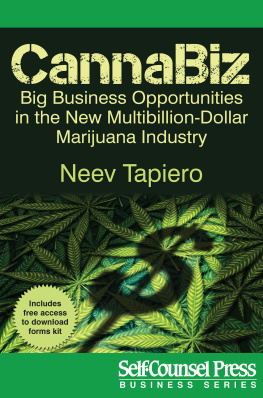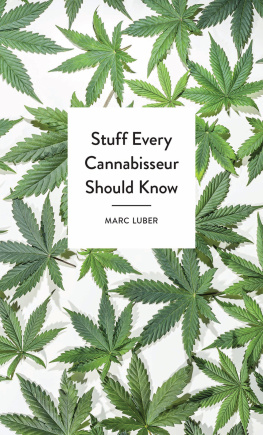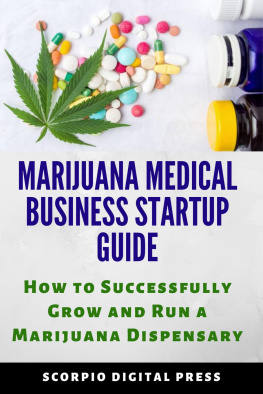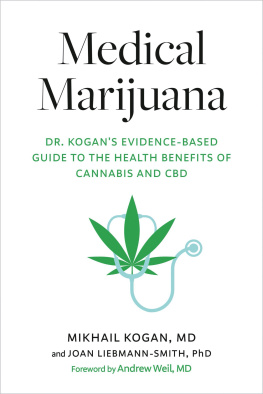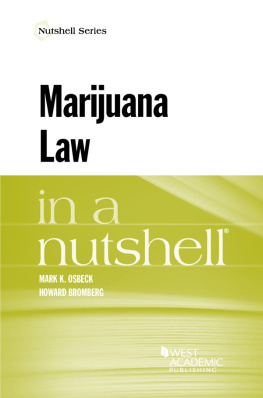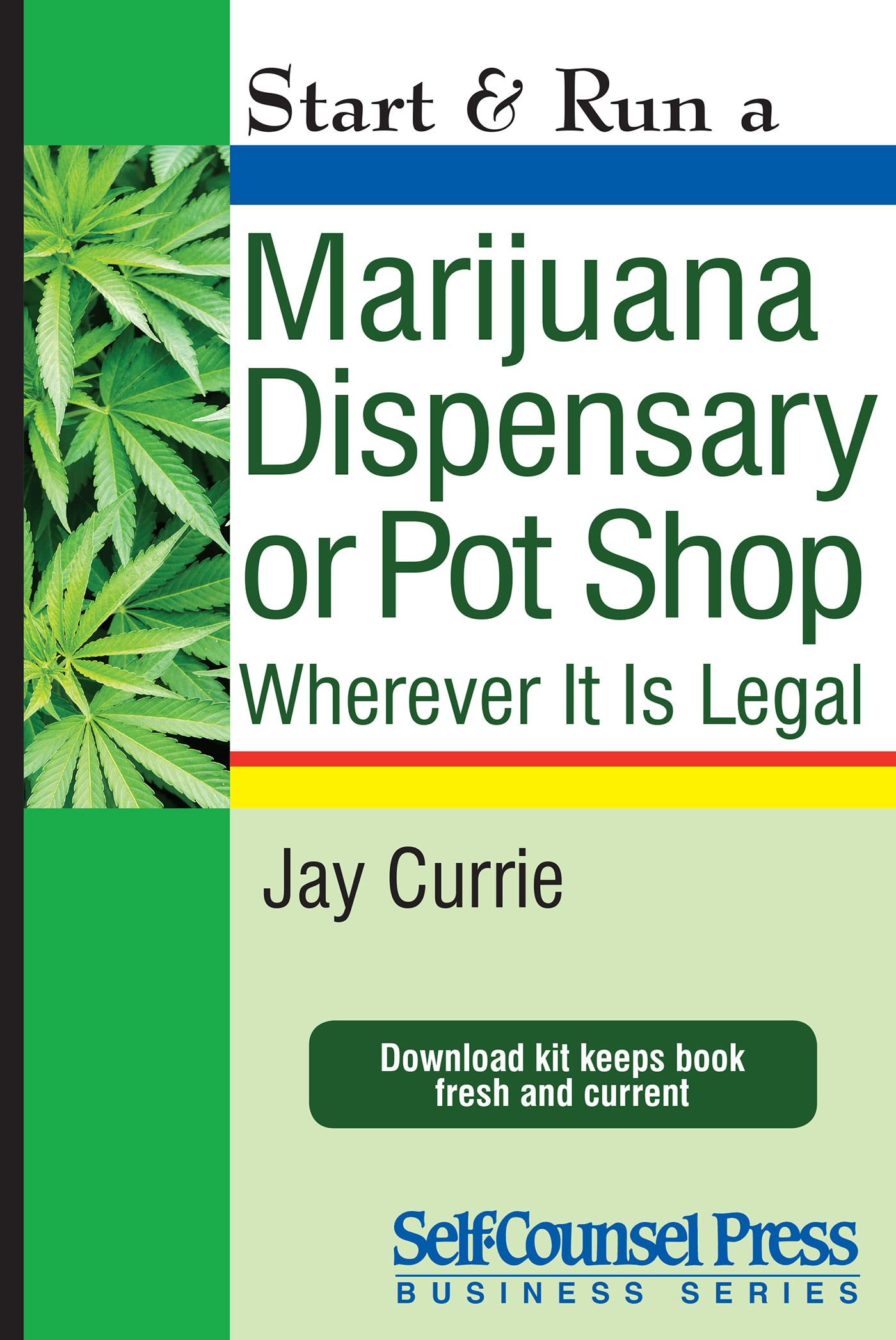Introduction:
The Green Rush and You
All over North America, the politics of marijuana have reached the tipping point. Whether it is the legalization of marijuana for medical use, the licensing of medical marijuana dispensaries, or the legalization of marijuana for recreational use, marijuana is entering the legal mainstream.
As the law changes, businesspeople have seen opportunities and entered the marijuana marketplace. Researchers from The ArcView Group, a cannabis industry investment and research firm based in Oakland, California, found that the US market for legal cannabis grew 74 percent in 2014 to $2.7 billion USD, up from $1.5 billion in 2013. As more states legalize either medical or recreational marijuana, ArcView projects the US marijuana market will expand to an $11 billion USD a year industry by 2019. In Canada, despite a regulatory disaster on the medical marijuana side, the authorized medical marijuana market is between $80$100 million CAD. If, as promised, the federal government legalizes recreational use, the overall market in that country is estimated to be worth up to $5 billion a year.
These are big numbers. Billionaire investors such as PayPal cofounder Peter Thiel are putting multimillion- dollar bets on companies in the space. Thiels partner Geoff Lewis understands something which, in many ways, is the theme of this book: Were fine with investing in businesses with regulatory ambiguity, because we believe that regulation follows public sentiment.
Unlike many of the businesses a person can start, the marijuana business is driven by demand on one side and regulation on the other. As a potential marijuana business owner you will be trying to meet the demand for marijuana products while, at the same time, complying with the regulatory regime in your particular jurisdiction. Its a balancing act.
This balancing act can be complicated by what is essentially an artificial, but legally important, distinction between medical and recreational pot usage. Back in the days of Prohibition there was a similar distinction. For medical use only allowed doctors to prescribe brandy or other alcohol to particular patients. As you might guess, alcohol quickly became the medication of choice for all manner of minor ailments.
For marijuana activists, medical marijuana was, and is, politically, a way forward in the campaign to legalize pot. Proposition 215 in California led to the Compassionate Use Act of 1996 which allowed people suffering from AIDS, cancer, and other chronic illnesses to grow or obtain marijuana when recommended by a doctor. Subsequent amendments to that law and its regulations has led to a widening of the exemptions created in 1996. The introduction of a medical marijuana user identification card in 2003 streamlined, to a degree, the medical marijuana regulation system in that state. Versions of the California system have been implemented in a dozen other states.
There are two key facts about medical marijuana in US states: First, there is very limited evidence of marijuanas medical efficacy. While there is plenty of anecdotal evidence that marijuana has a positive effect on everything from cancer to sleeplessness, the hard core, double-blind evidence is limited. Second, marijuana remains illegal under federal law regardless of why it is being used. Where a state has legalized pot for medical or recreational purposes, the present federal position is that it will not prosecute unless there is evidence of organized criminal involvement but, as well see, continuing illegality creates a lot of regulatory ambiguity.
Using the legalization of medical marijuana as a political wedge has been very effective, however, it creates more than a little confusion for a businessperson thinking about entering the marijuana market. Will he or she have to set up as a medical marijuana dispensary? Or is it possible in the jurisdiction to set up as a recreational pot shop? Here, at least, the laws and regulations in each state are unambiguous: Unless recreational marijuana is expressly legal in your state Washington, Colorado, Oregon, Alaska, and DC at time of writing you cannot set up recreationally.
The regulatory situation in the US is a bit confusing, however, state by state the regulatory situation is quite clear. This is in sharp contrast to Canada which well take a closer look at later on, but for a businessperson the state of Canadian regulation is more than a little difficult. Put simply, there is a medical marijuana regulation scheme in place, but its operation has been halted by a federal court case. That case was recently decided but has left the situation just as murky because the judge ruled that the current regulations were not fit for constitutional purpose, and gave the Federal Government six months to come up with new ones. The Federal Government announced its new medical marijuana regulations August 11, 2016. Basically, registered users may grow a limited amount of pot for their own use and they can have someone grow their pot for them. No provision was made for dispensaries.
This pretty much leaves a free-for-all in the medical space with dispensaries not authorized under the regulatory scheme being ignored by law enforcement in some areas and prosecuted in others. On the recreational side, the new government came in on a platform of legalization and regulation but it is all taking time to implement. Plus, in fine Canadian fashion, it is not at all obvious that the federal government, rather than the various provincial and municipal governments, is responsible for regulating the pot industry once marijuana has been legalized. There are ways forward for businesses but regulatory ambiguity barely begins to describe the Canadian situation.
Many Canadian marijuana entrepreneurs arent waiting for the legal dust to settle and Parliament to legalize recreational use. A growing grey market of medical marijuana storefront dispensaries has sprung up in major Canadian cities. These retail operations were largely ignored by law enforcement until late May, 2016 in Toronto when the police raided 43 medical marijuana dispensaries, arrested 90 people, and laid 186 criminal charges.
People are attracted to the marijuana business for a variety of reasons. Some are passionate advocates for the medicinal benefits of pot; others see marijuana as a matter of liberty; still others want to ride the rising tide of opportunity marijuana is creating. This book, and its author, are entirely agnostic as to the medical and/or spiritual benefits of marijuana, and while the politics of legalization have implications for the risk profile of a marijuana-based business, they are only one of a set of variables a businessperson needs to assess. What this book is attempting to do is help its reader consider the business prospects of a marijuana business and provide a basic guide to opening such a business in the US or Canada.
Cannabis, Marijuana, or Pot?
In various jurisdictions cannabis, which is the name of the genus of a flowering plant some of whose subspecies contain the psychoactive chemical tetrahydrocannabinol (THC), is referred to as marijuana for legal purposes. For many in the medical marijuana community, cannabis is the preferred term because of its scientific connotations. Marijuana is a more colloquial term and, for various reasons, is sometimes seen as somehow slighting or derogatory. Pot and the many other slang terms for cannabis is used all the time informally but generally in business a degree of formality is appropriate.


